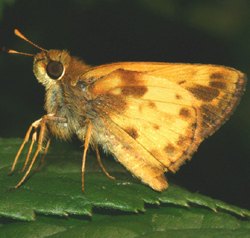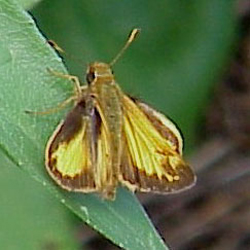Find a Butterfly
Zabulon Skipper
Poanes zabulon
Named
Boisduval and Leconte, 1834

Identification
Wingspan: 1 and 3/8 to 1 and 5/8." Very similar to Hobomok Skipper (P. hobomok). Males with extensive orange; females largely brown. Male zabulon may be distinguised from male hobomok by a comparison of the hindwing below; in zabulon the base of the wing is dark and encloses a yellow patch; the central yellow patch often encompasses numerous rusty-brown spots. Female zabulon (always dark) may be separated from the dark, pocahontas (Hobomok) females by the characters of the under hindwing: note the presence of a white edge to the costal margin and blue-gray highlights on the outer and inner portions of the wing.
Distribution
Central Kansas east through the southern Great Lakes Region east to Long Island; eastern Texas to central Florida and the mid-Atlantic States. In New England this species is regularly found only in Connecticut.
Status in Massachusetts
Zabulon Skipper is known from only a dozen or so records from the Springfield-Longmeadow area. Although all life stages have been observed, the paucity of records dictate that, at the present time, it should still be considered a vagrant —albeit with breeding status. While Scudder (1889) used the name zabulon to describe a butterfly "found throughout New England," he was, in fact, referring to hobomok. Klots (1951) recognized the difficulties of judging the historic distribution due to the earlier authors‘ confusion yet included Massachusetts in this species range. Maximum: 6, Longmeadow (Hampden Co.), R. Pease.

Flight Period in Massachusetts
Two flights: late May through mid-June and mid-August through mid-September. Outside dates: 27 May to 11 June, Springfield and Longmeadow, R. Pease and 14 August to 14 September, Springfield and Longmeadow, R. Pease.
Larval Food Plants
Grasses including purpletop (Tridens) and lovegrass (Eragrostis).
Adult Food sources
Opler and Krizek (1984) give a wide variety of nectaring sources including many introduced species such as Japanese Honeysuckle, Red Clover, Everlasting Pea, and Selfheal.

Habitat
As with hobomok including parks, gardens, and brushy stream edges.
Life Cycle
EGG: Cream-colored; dome-shaped. OVIPOSITION: Eggs laid singly on undersurface of grass blades. LARVA: (ssp. taxiles, Scott-1986) Orange-tan and cream with several lateral stripes and brown dots. CHRYSALIS: (ssp. taxiles, Scott-1986) Orange-tan and blue-gray with numerous brown dots and black marks. OVERWINTERING STAGE: unknown??
Account Author
Brian Cassie



